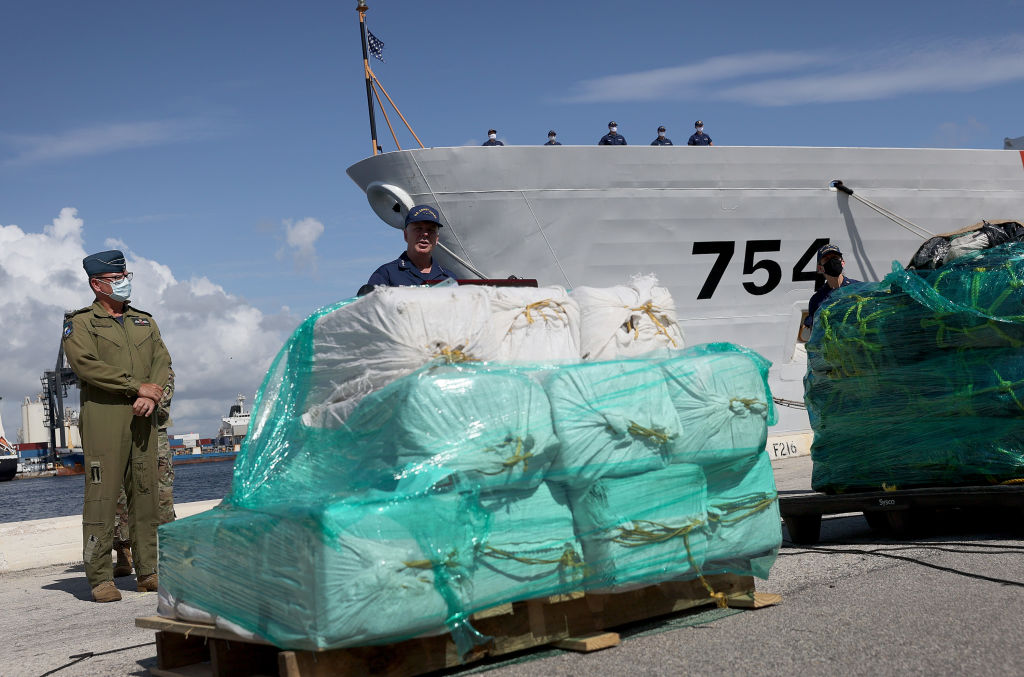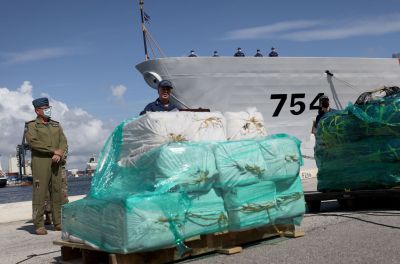At the Republican primary debate on Wednesday, Ron DeSantis eagerly waited for his turn to answer a question about whether he would use U.S. special operations forces to go after drug cartels on Mexican territory. “Yes, and I will do it on day one,” he said. He’s not the only one calling for unilateral intervention in response to the spiraling number of fentanyl overdose deaths. Former President Donald Trump is reportedly considering declaring the cartels as “enemy combatants” if he returns to the White House. But the suggested course of action comes with obvious and severe drawbacks, and ignores an existing but under-resourced military solution: maritime narcotics interdiction.
Annual drug overdose deaths in the U.S. rose to 106,000 in 2021, perhaps 71,000 of them from fentanyl, and this is likely an undercount. 2022 will likely be worse. Rural medical examiners’ offices struggle to fully autopsy the flood of victims, and some families prefer not to publicly attribute loved ones’ deaths to narcotics. Loss of American lives on this massive scale calls for a whole-of-government response, including the Department of Defense.
Former Attorney General Bill Barr holds up the successful fight against ISIS as an example of how special operations could work. For 20 years after 9/11, special operators honed their expertise at raids to capture or kill high-value terrorist targets in Afghanistan, Iraq, and elsewhere. There is no gainsaying their skill or derring-do, as I learned when providing them targets as a military intelligence and CIA officer. The understandable temptation is to use successful special operations tactics against narcotics traffickers, who are no less dangerous nor more deserving of quarter than terrorists. Yet it would be a tremendous strategic mistake to order such strikes in allied countries like Mexico.
Units such as the Green Berets of the Army’s 7th Special Forces Group provide invaluable services in helping train and assist partner forces in Latin America, and the U.S. can accomplish important counternarcotics objectives “by, with and through” our allies. And no one doubts the ability of a Tier One Special Mission Unit to get in and out of Mexico with the “jackpot” of a drug lord in tow. If a U.S. federal law enforcement officer joins them, there are no posse comitatus issues in that agent executing a lawful arrest. And, of course, killing the objective of the raid would be even easier. But if cartel leaders start being arraigned in U.S. courts pursuant to extraordinary rendition instead of extradition, or if infamous traffickers simply start disappearing, Mexico’s government will know its sovereignty is being violated.
Set aside for a moment that these individuals would be replaced by eager successors atop multibillion-dollar transnational criminal organizations. Also table that cartels would exact revenge against U.S. government officials and their families in ways they are quite capable of but historically refrained from demonstrating in el norte. The bigger problems would be that any Mexican government would either a) cease cooperation with U.S. intelligence and law enforcement regarding both narcotics and migration, or b) possibly shut down the $2 billion in daily commerce sluicing through the U.S.-Mexico border, triggering an economic crisis.
Murphy’s law applies to military operations: American and Mexican forces would eventually stumble into one another. Even in the exquisitely planned and rehearsed Abbottabad raid to kill Osama bin Laden, the U.S. lost a helicopter, and responding Pakistani fighter jets nearly got within engagement range of the surviving aircraft during exfiltration. Any military conflict with Mexico would be politically devastating to U.S. foreign relations with Latin America and the global South. And it would be foolish to assume quick success—the 1916 U.S. campaign to capture Pancho Villa failed, despite the best efforts of officers such as John Pershing and George Patton, and Mexican military staff colleges still study repelling a U.S. invasion, a la 1846, as their essential wargaming problem.
So what should the U.S. do to fight the narcotics menace? Friends south of the border point to the lack of a serious drug demand reduction program in the U.S., with nothing comparable to even the “Just say no” or “This is your brain on drugs” campaigns of the ‘80s and ‘90s. Weak gun control insisted upon by conservatives keeps an iron river of U.S. firearms headed south, hazarding Latin American police efforts against transnational criminal organizations. Meanwhile, liberal tolerance for prostitution and illegal immigration facilitates cartels’ brutal human trafficking networks, which sacrifice vulnerable young Latin American women to degenerate American men—a profit center for them, just like drugs.
These domestic policy problems are beyond the proper reach of the U.S. military. However, I learned as executive director of the U.S. Council on Transnational Organized Crime that there is a hugely successful, yet chronically under-resourced, Department of Defense counternarcotics program: maritime interdiction.
In U.S. Southern Command, interdiction efforts spearheaded by the Joint Interagency Task Force South, a proudly multinational effort based in Key West, Florida, represent one of the government’s least-heralded but most effective programs. In 2022 alone, JIATF South disrupted 371 smuggling events involving 300 tons of cocaine and 70 tons of marijuana with a wholesale value of $7.5 billion, saving an estimated 2,976 American lives. Cocaine is dangerous itself, but many fentanyl overdoses involve cocaine mixed by dealers, unwittingly to doomed users, with more lethal fentanyl.
JIATF South closely cooperates with 20 U.S. allies, including Mexico. As impressive as its haul of contraband is, JIATF South intercepts only one in 10 of the drug loads it identifies on the high seas headed toward the U.S. Why on earth are we not interdicting 90 percent of the drugs coming by sea into this country? That’s the question I asked, in stronger terms, when I heard this as a political appointee.
The simple, but infuriating, answer is that the U.S. Navy, Coast Guard, and Air Force lack—or more bluntly, refuse to assign—sufficient ships and aircraft to stop them. The Southcom commander usually has only two or three ships available for counternarcotics duty at any time. Even these ships are often called away on humanitarian assistance duty, in response to natural disasters and migration crises. Maritime interdiction does not require vastly expensive aircraft carrier battlegroups. Rather, it requires ships as small as Navy frigates or Coast Guard cutters—just big enough to carry a small helicopter—and unarmed patrol aircraft. The biggest weapon needed is usually just a well-handled sniper rifle to knock out a fast boat’s engine.
America’s deadly drug problem is multifaceted, requires interdisciplinary responses, and will take decades of more hard work to begin to fix. But the urge among politicians to unleash special operators in a “kinetic” solution to this problem is as understandable as it is wrong. Let special operators refocus from counterterrorism to their other vital missions, such as counterproliferation and enabling conventional operations in looming fights with other great powers.
DeSantis, a Navy judge advocate who served with SEAL Team One in Iraq, likely knows better. If not, he’d be wise to get the best advice of his secretary of defense (assuming one is even yet confirmed by the Senate), chairman of the Joint Chiefs of Staff, and combatant commanders before launching a covert action on “day one” of his administration. A new president’s workday on January 20 begins at noon and is filled with an inaugural address, transfer of the nuclear launch codes, a congressional luncheon, a parade, signing executive orders, and several fancy-dress balls—there’s little time for reflection about major decisions.
Let’s not blunder into a war with Mexico. Rather, whether by building more ships and planes, making more efficient use of the ones we possess, or ideally both, if we can resource maritime counternarcotics efforts to get interdictions up from 10 percent of identified drug loads to all of them, we could save as many as 30,000 American lives per year.






Please note that we at The Dispatch hold ourselves, our work, and our commenters to a higher standard than other places on the internet. We welcome comments that foster genuine debate or discussion—including comments critical of us or our work—but responses that include ad hominem attacks on fellow Dispatch members or are intended to stoke fear and anger may be moderated.
With your membership, you only have the ability to comment on The Morning Dispatch articles. Consider upgrading to join the conversation everywhere.